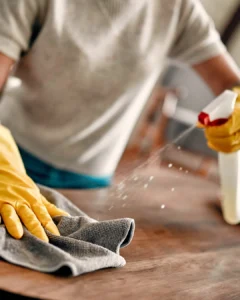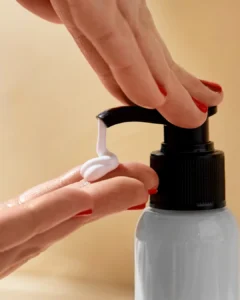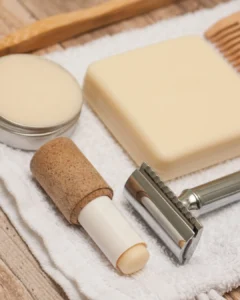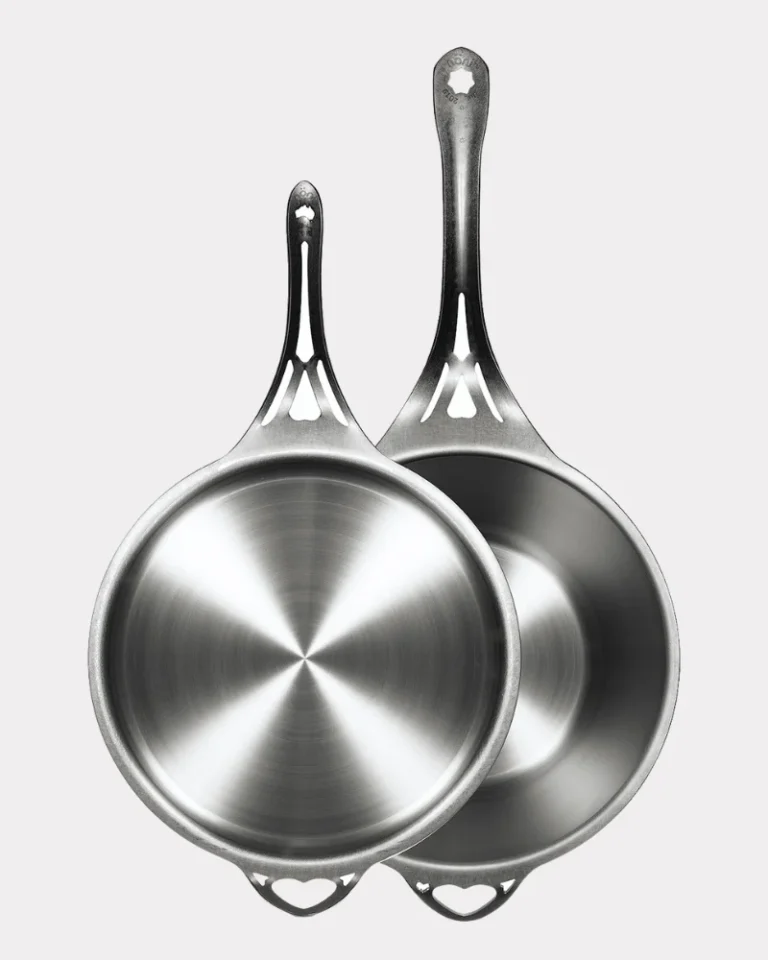This post may contain affiliate links. By browsing this website, you agree to our disclaimer, privacy policy, and terms of use.
If you’re new to the low-tox or non-toxic living world, you’re probably feeling a bit overwhelmed. Where do I start? How are companies getting away with this? How much time and money is this going to cost?
I feel you. All of us at THC have been in your shoes and we are here to help.
While brainstorming on how best to help our community, we thought it would be best to create this guide on the top 15 most common toxic chemicals hiding in your home PLUS easy ways to swap them out.
From the cleaning supplies under our sinks to the personal care products in our bathrooms and even the pots and pans in our kitchens, potential hazards are hiding in plain sight.
Yes, those sneaky little toxins are everywhere, and it’s time we start paying attention to them!
Now, I bet you’re thinking, “But wait, I use all sorts of products to keep my home clean and smelling fresh. They can’t be that bad, right?”
Well, buckle up because we’re about to uncover some startling truths about the invisible threats hiding in many of the household products we use daily.
They contain a wide range of harmful chemicals that can have some pretty nasty effects on our health. We’re talking about everything from skin burns to respiratory issues and even systemic long-term damage if we’re exposed to too many chemicals for too long.
But don’t worry! The THC team is here to help you navigate this chemical minefield and find some safer alternatives.
So, let’s take a deep breath (of clean, toxin-free air, of course) and get ready as we expose the most common toxins hiding in our homes.
How these toxic chemicals enter our bodies:
First, and most commonly, is through inhalation. When you’re misting cleaning spray onto your kitchen counters, as one does, you’re also breathing in the tiny particles of the product as it evaporates into the air.
Those chemicals are making their way into your lungs, and from there, they can pass into your bloodstream and affect organs and other body systems far from the original entry point. Pretty scary!
Another common way that toxic chemicals enter our system is through skin contact. Did you know that our skin is our largest organ and absorbs nearly 64% of substances applied to it? This is really applicable when it comes to our personal care products and cleaning products, especially if you’re not wearing gloves.
That means when you’re using products containing toxins, they can be introduced directly into your bloodstream through skin permeability. Just like how some medication can be delivered through a patch you stick on your skin.
And it’s not just the obvious culprits like cleaning sprays or tile scrubs. Think about the dishwasher detergent that remains on your dishes after you wash them, which then transfers to the food you eat. Or the disinfectant spray you use on your bathroom countertop that you touch each time you turn on the faucet.
These tiny exposures can add up to big long-term health consequences.
Our Level of Exposure To Toxic Chemicals Matters
It can be easy to assume that because large corporations have deemed these chemical products safe enough to stock on store shelves, they must be harmless. But, it’s important to recognize that just because a product is widely available doesn’t necessarily mean it’s safe for long-term use or repeated exposure.
Exposure to even small doses of harmful substances over a long period of time can lead to an accumulation of toxic chemicals in the body. Each spray of disinfecting liquid, a drop of detergent, or a splash of bleach adds up.
Short-term exposure can result in skin and respiratory reactions that go away in a few hours. But it’s the long-term exposure to chemicals in small doses that we really need to worry about.
While a single instance might not be toxic, the accumulated exposure over 10, 15, or 20 years is when we start to see serious long-term health effects appear. It’s like a slow, silent buildup of toxins that, once they reach a tipping point, can very quickly cause serious health issues.
This is why we need to be aware of the chemicals we’re bringing into our homes and how much we’re exposing ourselves to on a daily basis.
Complete List of Toxic Chemicals Hiding in Everyday Products:

Cleaning Products
When it comes to cleaning products, we often assume that if it makes our home sparkle, it must be safe, right? Well, not always. Here are some common cleaning products that may contain harmful chemicals:
Multi-purpose cleaners: Like countertop sprays, glass cleaners, stainless steel cleaners, bathroom disinfectants, and soap scum removers. These often contain a cocktail of chemicals, including VOCs, fragrances, and even chlorine or ammonia. VOCs are directly linked to lung cancer, and the fumes are easily inhaled.
Oven cleaners: Due to the tough cleaning they perform, oven cleaners frequently contain lye or sodium hydroxide, which can cause severe skin and eye burns if not handled properly.
Toilet bowl cleaners: Many toilet bowl cleaners contain hydrochloric acid or chlorine bleach, both of which are extremely corrosive and toxic. Mixing these cleaners with other products can generate chloramine, which is very dangerous.
Air fresheners: Air fresheners are some of the most toxic everyday products. Most air fresheners contain VOCs, which can irritate the respiratory system and potentially contribute to long-term health problems.
If you use any type of product that contains synthetic fragrances in your household, including air fresheners, laundry detergent, dryer sheets, scent boosters, and dish soaps, be wary of phthalates, which are commonly found in fragranced household products and have been linked to breast cancer.
Dish & dishwasher soaps: These contain often contain chemicals like ethanolamines (a known carcinogen), 1,4-dioxane (a known carcinogen), phthalates (endocrine disruptors), fragrances (VOCs), and chlorine that leave a residue on your dishes that you ingest each time you eat. These chemicals also release dangerous fumes that can cause permanent damage to your respiratory system.
Bug Sprays: Whether it is ant sprays, roach sprays, or bug bombs meant to kill or deter bugs, they likely contain chemicals called polycyclic aromatic hydrocarbons (PAHs) that contribute to liver cancer by disrupting metabolic processes and promoting carcinogenesis.
Personal Care Products

Moisturizers: Many common moisturizers contain polyacrylamide (with possible acrylamide contamination) and PTFE (with possible PFOA contamination), as well as parabens, which can disrupt the body’s natural hormonal regulation, resulting in fertility issues, reproductive organ problems, and an increased risk of cancer.
Sunscreens: Chemical sunscreens contain several ingredients that have raised health concerns, including benzene, oxybenzone, avobenzone, homosalate, and octinoxate, due to their carcinogenic and hormone-disrupting effects.
Shampoos and Conditioners: These often contain chemicals that, while providing short-term benefits like clean, shiny, and smooth hair, can have long-term harmful effects on health. Some of these chemicals include sulfates, parabens, polyethylene glycols (PEGs), phthalates, formaldehyde, dimethicone, retinyl palmitate, alcohols, fragrances, and synthetic colors.
Soaps and Body Washes: Common commercial soaps and body washes are often packed with some pretty nasty stuff, including foaming agents known as ethanolamines (like DEA and TEA). They also tend to include synthetic fragrances that are made from petroleum-based chemicals that can cause allergies, asthma, and endocrine disruption.
Plus, phthalates are added to make those synthetic fragrances stick to our skin and hair, but these chemicals are endocrine disruptors and can cause reproductive harm and are harmful chemicals to the environment.
Perfumes and Body Splashes: We all love to smell amazing, but at what cost? Styrene, which has been declared a probable human carcinogen, is often lurking in these products. Benzaldehyde is another culprit – it’s a narcotic that can irritate the lungs and eyes, cause nausea and abdominal pain, and even damage kidneys.
And get this: methylene chloride has been banned by the FDA for its severe toxicity, but it may still be found in products listed under “fragrance.”
Cosmetics

Foundation: Foundations may contain heavy metals like lead, mercury, or chromium in trace amounts that can accumulate in the human body and potentially cause health problems. They also contain polyethylene glycol (PEGs). These are often contaminated with ethylene oxide (a known human carcinogen) and 1,4-dioxane (a possible human carcinogen). The worst part? PEGs can enhance the penetration of harmful ingredients into the skin!
Mascaras, Eyeliners, and Eyeshadows: Beauty products like mascaras, eyeliners, and eyeshadows may contain coal tar dyes like PPD (paraphenylenediamine), which can cause allergic reactions. And watch out for talc, which has been linked to an increased risk of ovarian cancer when inhaled, though further research is ongoing. Look for talc-free options, just to be safe!
Lip Products: Lipsticks may contain trace amounts of lead, similar to the concerns with foundations. Eeek! And lip balms and glosses? They may contain phthalates, which are suspected endocrine disruptors.
Nail Polishes: They often contain three harmful chemicals: dibutyl phthalate (DBP), toluene, and formaldehyde. These can disrupt hormones, harm the nervous system, and irritate the skin. Not exactly the kind of self-care we’re looking for, right?
Food Packaging and Kitchenware

Kitchen Utensils and Appliances
Plastic Cutting Boards: Plastic cutting boards can contain Bisphenol A (BPA), a chemical that may leach into food and has been linked to various health issues like hormonal disruption and potential developmental problems.
Aluminum Foil: Aluminum foil can potentially leach aluminum into food when used for cooking, with excessive aluminum intake being associated with neurological issues and other health concerns.
Coffee Makers: Plastic components in coffee makers can contain thousands of chemicals that may leach into hot, acidic substances like coffee, potentially leading to chemical exposure and health risks.
Food Packaging
Canned Goods: Canned food often contains Bisphenol A (BPA), which has been linked to hormonal disruptions, metabolic disorders like PCOS, certain cancers, and developmental and behavioral issues like ADHD, anxiety, and depression.
Greaseproof and Waterproof Packaging: Sometimes used in greaseproof and waterproof packaging for food and plastic cling wrap for raw meats, PFAS are a group of chemicals raising concerns about potential impacts on the immune system, childhood development, and certain cancers.
Plastic Food Containers: Plastic containers can release harmful chemicals like BPA and phthalates into food, especially when exposed to heat or acidic foods, posing risks of hormonal disruption and other health problems.
Cookware
Non-Stick Cookware: Traditionally coated with polytetrafluoroethylene (PTFE), commonly known as Teflon, these pans can potentially release harmful chemicals if overheated. Opt for pans with ceramic or stainless steel non-stick coatings that are generally considered safer.
Lead: Found in older glazed ceramics or imported cookware, lead can leach into food, especially acidic foods. Avoid using cookware with chipped or cracked glazes, and dispose of any cookware suspected to contain lead.
Steps You Can Take Towards a Safer Home Environment
I know we just bombarded you with a whole bunch of scary information about the hidden chemicals potentially lurking all around your home.
But don’t worry, we didn’t do this to send you into a panic! We just want to make sure you’re fully informed about the products you’re buying and how they can affect your health.
And here’s the best part – there are so many approachable and affordable ways to avoid these chemical-laden products in your home.
Opt for Natural Alternatives
Now, we know the idea of switching to natural products might seem a little intimidating at first, but trust me, there’s a whole world of amazing options out there. We’re talking about cleaning products and personal care items with fewer ingredients that you can actually pronounce.
When it comes to all-natural personal care products, you’ll be blown away by the fantastic options available.
From natural deodorants to gentle, plant-based body washes, there’s something for everyone.

And if you regularly use sunscreen, look for mineral-based ones that use natural ingredients like titanium dioxide and zinc oxide. They’re way better for you than those chemical sunscreens with all those harmful ingredients.
And don’t even get us started on the incredible companies creating safer products for cleaning using 100% natural ingredients.
Or, if you don’t want to buy new cleaning products, you can even start making your own cleaning solutions with vinegar, baking soda, and essential oils.
Since we switched over to all-natural products in our home, our space has never been cleaner, our skin has never looked better, and we’ve never felt more amazing!
Choosing Non-Toxic Kitchenware and Food Storage
Opt for Stainless Steel and Silicone Food Storage: Brands like LunchBots offer BPA-free containers made from 100% stainless steel, which ensures no plastic touches your food. Home and Harvest provide spill-proof, rust-, and corrosion-proof stainless steel containers with silicone lids.
Choose Non-Toxic Cookware: For cooking, the most non-toxic options would be stainless steel, 100% ceramic, and cast iron. Our expert team rounded up the best non-toxic cookware picks for the TFC community.
Select Kitchenware Made from Safe Materials: Glass, stainless steel, cast iron, and wood are among the best materials for non-toxic kitchenware. These materials are well-researched, time-tested, and generally considered safe for food preparation, cooking, and storage.
Remember:
- Avoid using scratched or chipped non-stick cookware, as these can release harmful chemicals into your food.
- Don’t overheat non-stick pans, as this can also break down the coating and release toxins.
- Consider alternative cookware materials like cast iron or stainless steel, which are known for their durability and safety.
- Replace older, potentially lead-containing cookware, especially if it’s chipped or cracked.
Improve Indoor Air Quality
Did you know that the air in our homes is often more polluted than the air outdoors? Thanks in large part to things like cleaning products, dust, and even furniture. Crazy, right? But don’t worry. There are several things you can do to improve your indoor air quality at home.
Opt for non-toxic furniture brands when possible. Did you know that couches, mattresses, bed frames, and carpets are chock full of some of the most toxic household chemicals out there? Non-toxic furniture companies, on the other hand, use only the safest materials to craft lifelong treasures.
Open those windows whenever possible, especially when you’re using cleaning products. it can help dilute indoor pollutants by bringing in fresh outdoor air and carrying indoor air pollutants out of your home. It’s like a breath of fresh air, literally!
Purchase an air purifier. Air purifiers with HEPA filters can trap allergens and pollutants, improving indoor air quality and potentially reducing allergy and asthma symptoms.
Consider adding some air-purifying plants like snake plants or peace lilies to your kitchen to naturally filter your air.
Avoid smoking indoors, use natural cleaning supplies, and minimize the use of air fresheners. And if you have sensitive lungs or allergies, it’s super important to avoid substances that can make your symptoms worse, like particulates from candles, incense, perfumes, and harsh household cleaners.
This was your full guide to avoiding toxic chemicals in everyday items!
We know it can be overwhelming to think about all the hidden toxins that might be lurking in your home. But don’t worry. We’re in this together, and the key is to take small, manageable steps towards creating a healthier home.
Don’t feel like you need to overhaul everything at once – just start small and make gradual changes.
Swap out your conventional cleaning products for natural alternatives as they run out, invest in some non-toxic cookware when you need a new pot or pan, and consider adding a few air-purifying plants to your space.
Every small step you take towards a toxin-free home is a step in the right direction. By making these changes and sharing our knowledge with others, you’re not only protecting your own health but also contributing to a safer and healthier world for everyone.






